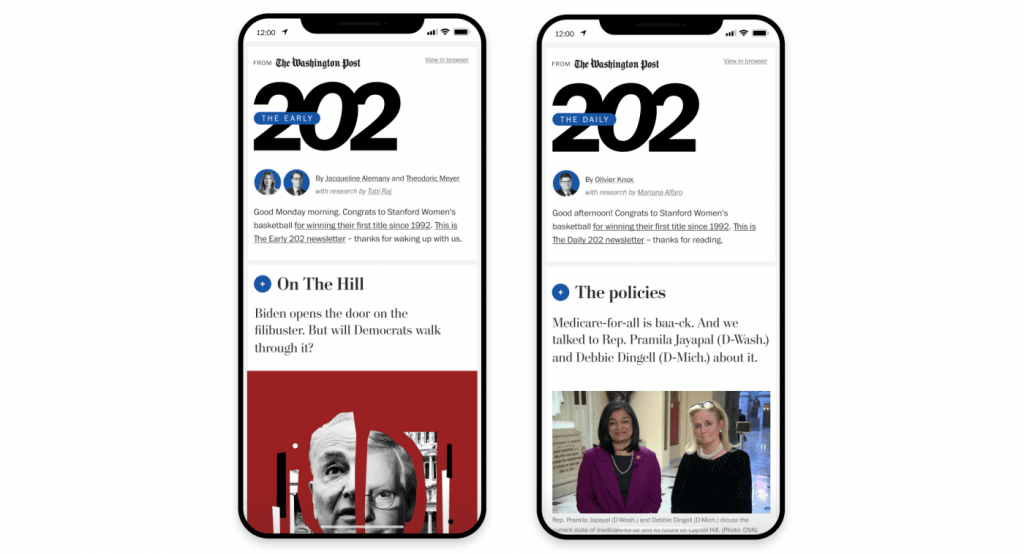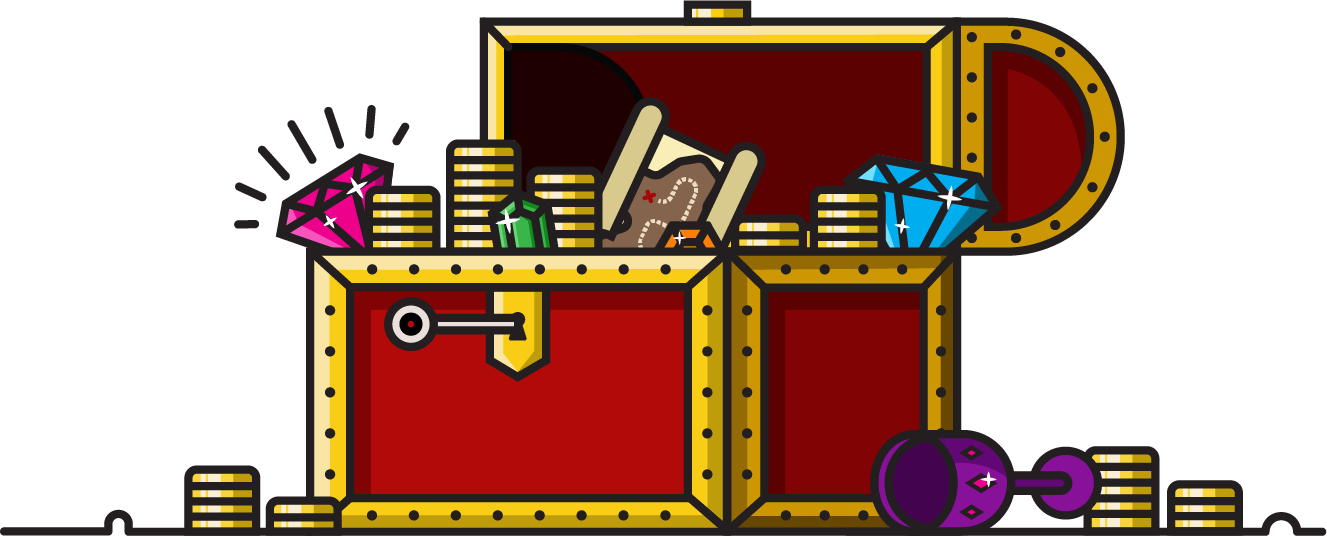Business newsletters have been a cornerstone of marketing for years for both small businesses and enterprises alike. No matter what other marketing trends come and go, business newsletters—now most often in the form of email newsletters—are here to stay for a reason.
Few other marketing channels can match business newsletters’ consistency and effectiveness, which is why every business owner, even small business owners, should consider having one, including B2B companies. Read on to discover why business newsletters work and what our top newsletter ideas are.
Read more: Buyer’s Guide to Email Marketing Software
In this article...
Why Business Newsletters Work
As the default avenue for business newsletters, email may feel a little dated or traditional compared to some newer digital marketing channels, such as TikTok. However, whether your company is B2B or B2C, email is still one of the most effective marketing channels you can use. In fact, 77% of B2B marketers use email newsletters for their content marketing.
Why business newsletters are effective for B2B companies
Email newsletters are especially beneficial for B2B companies because their intended audience, usually employees, already spend hours attending to their email account during the workday.
In 2021, workers spent 149 minutes a day, or 2.5 hours, checking their business email while they were at work, according to Adobe’s annual email use survey. This indicates that it may be easy for recipients to take a few minutes to read a company newsletter for relevant business news, industry trends, tips, and strategies.
Email communication vs social media
Behavior surrounding email contrasts with that of other marketing channels, such as social media, which employees might only be able to check on their breaks — not to mention that some companies block access to these sites during work hours.
Even if the employees do have access to social media and other marketing channels at work, most people don’t want to use their brief breaks or precious off hours to engage with work-related content if they can help it.
Audiences turn to email for professional content consumption
Those who actively subscribe to your email newsletter show they are at least somewhat interested in reading your content and hearing about your products or services. And they’re more likely to do so throughout their workday through email, while social media is more often used for breaktime and personal interests.
Read more: What Are All the Ways People Demonstrate Intent?
It’s clear that email newsletters for businesses will remain a mainstay of the marketing mix in the coming year. If you’re wondering how you can make the most of your business newsletter, read on to discover our top tips for creating and sending one.
Read more about startup and small business marketing on Fit Small Business: 25 Best Business Email Examples
Newsletter Communication Strategy Tips
Determine the purpose of your newsletter
Before you begin, you should determine the purpose of your B2B newsletter and figure out where it fits into your sales funnel. For most companies, business emails fall into the middle of the funnel.
The potential customer has already expressed awareness of and interest in your business by signing up for the email, but they’re not quite ready to buy yet. As you craft your newsletter content, stay focused on moving readers through the sales funnel, and write your copy with that in mind.
For instance, send a list of essential features for a software category or send short product reviews. That way, when they’re ready to buy, they’re armed with that knowledge of what features and names to look for when evaluating vendors.
Personalize as much as possible
Though you’ll want a newsletter template for consistency and efficiency, personalize the newsletter as much as possible based on the subscriber’s behavior on your site and interaction with your email newsletters. The subject line of the email newsletter is the first chance to get the target audience’s attention, followed by a personalized note and the curated newsletter put together just for them.
Read more: Understanding Personalized B2B Marketing
Choose a visually appealing design with clear CTAs
Copy isn’t the only important element. You should also choose a visually appealing design with clear calls to action (CTAs) that fit with your company branding. Also, ensure your newsletter is optimized for mobile and tablets, as well as desktop. It helps to have an email template in place to ensure consistency and boost efficiency in sending email newsletters.

The Washington Post’s award-winning The Early 202 newsletter, known for its clean, visually appealing layout, was relaunched late 2021 with added features. Photo credit: Washington Post
If you have the budget, you should also invest in email marketing software or an integrated customer relationship management (CRM) system to manage your business newsletter subscribers and their email addresses. A CRM will allow you to segment your customers into different groups, so you can target their interests more specifically.
Also consider adding a CTA in your social media and blog posts to subscribe to the newsletter, including a link to make it easy to do so.
Read more: How to Use CRM for Customer Engagement
Consider the best time and frequency
When scheduling the newsletter to send to readers on your email list, evaluate your analytics to figure out the most effective time to send your emails and optimize for that time.
Don’t send on weekends or bank holidays, when your email subscribers are very unlikely to be checking their work email. If you have international readers across many different time zones, keep in mind that you might need to send the email in different batches.
Moreover, you should send emails frequently, but not too frequently. If you send an email every day, potential and existing customers might get annoyed and unsubscribe, but if you only send one once every few months, they might forget about you.
Weekly or every other week is a good frequency to start with. However, that’s not a blanket rule. The frequency of your email newsletters will depend on your brand, industry, audience, and strategy. Even better, give subscribers options for how often they want to hear from your company. And Mondays tend to have the highest open and click-through rates, so no matter the frequency, send your newsletter on that day of the week.
Use A/B testing and frequently investigate your analytics using tools like Campaign Monitor, so you can continually improve your newsletter’s timing and tactics.
Evaluate other B2B newsletters
Finally, we recommend subscribing to some B2B newsletters and analyzing them critically to figure out what you do and don’t like. If you’re not sure where to start, we’ll offer some examples in the next section to help you get started.
Read more: 5 Ways B2B Lead Gen Has Changed in the Past Decade
B2B Newsletter Examples
To give you an idea of how different approaches can work for different companies, we’ve rounded up four business newsletters that have leveraged different strategies to achieve success.
The Hustle
Founded in 2014 as a daily newsletter, The Hustle has now become a full-fledged media company with 1.5 million subscribers, a podcast, and a paid premium research community. The daily emails are short, taking five minutes or less to read, and written in a funny, engaging style.
The content features a roundup of various business and entrepreneur news stories from the previous day, such as product launches and acquisition announcements. They also include graphics and memes to make it more visually appealing and inject some humor into the newsletter.
Taco from Trello
This is a business newsletter sent by Trello, which is a web-based Kanban-style productivity application. The email is very short on copy but heavy on graphics and visuals to make it extremely quick to read.
The emails go out approximately twice a month, so subscribers aren’t overwhelmed by the frequency. The newsletter includes lots of productivity content that is not specifically about Trello, so their newsletter isn’t part of an email campaign per se that constantly pushes their products like a typical transactional email. Readers still get value even if they don’t use Trello.
Examples of general productivity content include “How to Create A Realistic and Enjoyable Career Path for Your Team Members” and “5 Ways to Reinvigorate and Level-Up Your Home Office.” They also include Trello-specific content, such as “6 Delightful Trello Features to Try,” to help subscribers get more out of the application.
SparkToro
SparkToro is an audience research tool that launched in Spring 2020; it was co-founded by Rand Fishkin, who helped to found Moz. SparkToro started its monthly newsletter in Fall 2021. Each newsletter includes three audience research tips, as well as a roundup of latest news items and tweets from across the web.
This newsletter takes the opposite approach of Taco from Trello, including mostly text with no visual “filler.” You can also read past newsletters on the SparkToro website to see if you would like the content before you commit to subscribing.
Grammarly
Grammarly takes a unique approach to business newsletters. Each week this service sends out an Insights email, showing how much you used Grammarly and how your performance compares to past weeks, as well as other users on the site.
This feature fuels people’s competitive streak and encourages them to use the tool even more. The weekly newsletter emails are visually appealing, including charts, graphs, and images for each metric. Grammarly also sends out the occasional email linking to their blog content, which is full of informative tips for communication, in addition to the statistical Insights email.
New York Times
The New York Times has millions of subscribers to its print and digital newspaper, adding nearly half a million more subscribers in Q3 of 2021. Though the NYT offers dozens of newsletters delivered exclusively to paid subscribers, it also offers several, albeit a more limited selection, of email newsletters for non-subscribers as well, such as a weekly Gameplay newsletter and a twice weekly Wildfire Tracker newsletter.
Ready to Connect With Your Target Audience With a Company Newsletter?
It’s easy to get started right away, for instance. LinkedIn, for instance, has an easy-to-use LinkedIn newsletter service. However, if you need more personalized suggestions to up your B2B newsletter game, we’ve got you covered with recommendations for email marketing platforms and CRM systems. Contact us, and we’ll connect you with one of our unbiased technology experts who will help you find the perfect platform for your business.
Starting an email newsletter can be tough for startups who need to build an audience to begin with. Read this next: Owned Audience: How to Build an Audience for your Business

